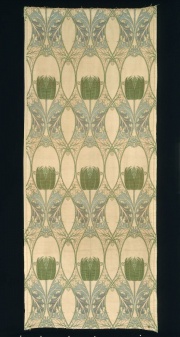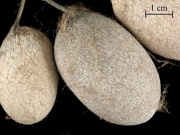Difference between revisions of "Tussah silk"
Jump to navigation
Jump to search
(username removed) |
|||
| (3 intermediate revisions by 2 users not shown) | |||
| Line 1: | Line 1: | ||
| − | [[File:1986.754-E9008CR-d1.jpg|thumb| | + | [[File:1986.754-E9008CR-d1.jpg|thumb|Furnishing panel<br>MFA # 1986.754]] |
== Description == | == Description == | ||
| − | Silk fibers produced by wild silk worms (''Antheraea mylitta''). The filaments of Tussah, or [ | + | Silk fibers produced by wild silk worms (''Antheraea mylitta''). The filaments of Tussah, or [[wild%20silk|wild silk]], is coarser and stronger than cultivated silk fibers. It is rarely weighted. Wild silk is also brownish and more difficult to bleach so it is usually dyed in dark colors. See also [[silk|silk]]. |
== Synonyms and Related Terms == | == Synonyms and Related Terms == | ||
| Line 8: | Line 8: | ||
Tusser silk; wild silk; raw silk | Tusser silk; wild silk; raw silk | ||
| − | [[File:Anth.mylitta_grp.det_Irene.jpg|thumb|Indian tropical | + | [[File:Anth.mylitta_grp.det_Irene.jpg|thumb|Indian tropical tasar silk moth, ''Antheraea mylitta'']] |
| + | ==Physical and Chemical Properties== | ||
| − | + | * Fiber has longitudinal striations. | |
| + | * Cross section is elongated triangle. | ||
| − | + | ==Resources and Citations== | |
| − | == | ||
| − | + | * M.Brooks, S.O'Conner, J.McDonnell "The Application of Low-energy X-radiography in the Examination and Investigation of Degraded Historic Silk Textiles" ICOM Preprints, Edinburgh, Vol. II, p.670-79, 1996. | |
| − | |||
| − | |||
| − | |||
| − | |||
| − | |||
| − | |||
* R. J. Gettens, G.L. Stout, ''Painting Materials, A Short Encyclopaedia'', Dover Publications, New York, 1966 Comment: p. 231 | * R. J. Gettens, G.L. Stout, ''Painting Materials, A Short Encyclopaedia'', Dover Publications, New York, 1966 Comment: p. 231 | ||
| Line 31: | Line 26: | ||
* ''Identification of Textile Materials'', The Textile Institute, Manchester, England, 1985 Comment: p. 13 | * ''Identification of Textile Materials'', The Textile Institute, Manchester, England, 1985 Comment: p. 13 | ||
| − | * | + | * Comment: www.fabrics.net |
[[Category:Materials database]] | [[Category:Materials database]] | ||
Latest revision as of 11:16, 22 June 2022
Description
Silk fibers produced by wild silk worms (Antheraea mylitta). The filaments of Tussah, or Wild silk, is coarser and stronger than cultivated silk fibers. It is rarely weighted. Wild silk is also brownish and more difficult to bleach so it is usually dyed in dark colors. See also Silk.
Synonyms and Related Terms
Tusser silk; wild silk; raw silk
Physical and Chemical Properties
- Fiber has longitudinal striations.
- Cross section is elongated triangle.
Resources and Citations
- M.Brooks, S.O'Conner, J.McDonnell "The Application of Low-energy X-radiography in the Examination and Investigation of Degraded Historic Silk Textiles" ICOM Preprints, Edinburgh, Vol. II, p.670-79, 1996.
- R. J. Gettens, G.L. Stout, Painting Materials, A Short Encyclopaedia, Dover Publications, New York, 1966 Comment: p. 231
- G.S.Brady, Materials Handbook, McGraw-Hill Book Co., New York, 1971 Comment: p. 722
- Rosalie Rosso King, Textile Identification, Conservation, and Preservation, Noyes Publications, Park Ridge, NJ, 1985
- Identification of Textile Materials, The Textile Institute, Manchester, England, 1985 Comment: p. 13
- Comment: www.fabrics.net

